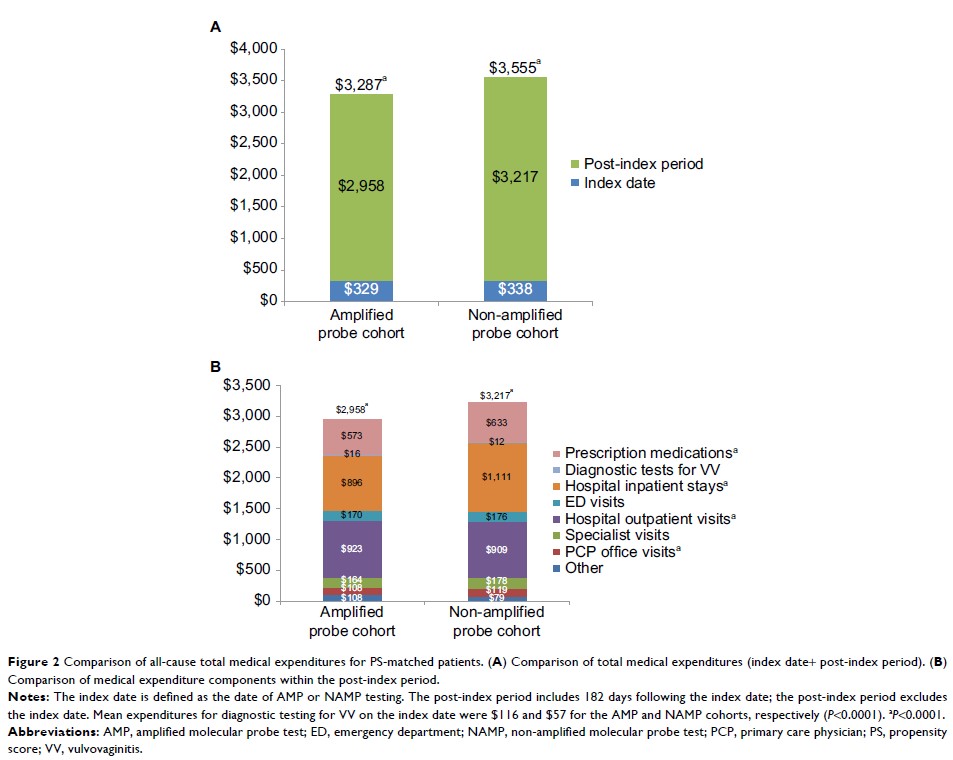108605
论文已发表
注册即可获取德孚的最新动态
IF 收录期刊
- 3.4 Breast Cancer (Dove Med Press)
- 3.2 Clin Epidemiol
- 2.6 Cancer Manag Res
- 2.9 Infect Drug Resist
- 3.7 Clin Interv Aging
- 5.1 Drug Des Dev Ther
- 3.1 Int J Chronic Obstr
- 6.6 Int J Nanomed
- 2.6 Int J Women's Health
- 2.9 Neuropsych Dis Treat
- 2.8 OncoTargets Ther
- 2.0 Patient Prefer Adher
- 2.2 Ther Clin Risk Manag
- 2.5 J Pain Res
- 3.0 Diabet Metab Synd Ob
- 3.2 Psychol Res Behav Ma
- 3.4 Nat Sci Sleep
- 1.8 Pharmgenomics Pers Med
- 2.0 Risk Manag Healthc Policy
- 4.1 J Inflamm Res
- 2.0 Int J Gen Med
- 3.4 J Hepatocell Carcinoma
- 3.0 J Asthma Allergy
- 2.2 Clin Cosmet Investig Dermatol
- 2.4 J Multidiscip Healthc

Health care utilization and costs following amplified versus non-amplified molecular probe testing for symptomatic patients with suspected vulvovaginitis: a US commercial payer population
Authors Ackerman SJ, Knight T, Wahl PM, Cartwright CP
Received 25 October 2018
Accepted for publication 6 January 2019
Published 20 February 2019 Volume 2019:11 Pages 179—189
DOI https://doi.org/10.2147/CEOR.S191831
Checked for plagiarism Yes
Review by Single-blind
Peer reviewers approved by Dr Amy Norman
Peer reviewer comments 2
Editor who approved publication: Professor Samer Hamidi
Background: Vulvovaginitis (VV) is a common reason
women seek medical attention in the USA. Both the non-specific clinical
presentation and risk of preterm labor or delivery necessitate accurate identification
of the causative agents to guide appropriate therapy. The diagnostic accuracy
of amplified molecular probe testing (AMP) has been shown to exceed that of
non-amplified molecular probe (NAMP) by 20%–25%.
Objective: To
evaluate the impact of diagnosis with AMP testing on health care utilization,
direct costs, and health outcomes, compared with NAMP, for symptomatic patients
with suspected VV from a commercial payer perspective.
Methods: Symptomatic
women (aged 18–64 years) who underwent VV testing with AMP or NAMP from January
1, 2012–December 31, 2016 were identified using the Truven Health Analytics
MarketScan Database; those with continuous medical and pharmacy benefit
enrollment 6 months pre/post AMP or NAMP testing were included. Patients were
propensity score (PS) matched and 6-month all-cause health care resource
utilization, all-cause direct costs (2017 USD), risk of all-cause
hospitalization, and risk of preterm labor or delivery were compared between
cohorts.
Results: After
PS match (N=46,810 per group, mean age 34.2 years), AMP had significantly
(all P <0.0001)
fewer mean hospital outpatient visits (AMP 0.9 vs NAMP 1.0), primary care
physician office visits (AMP 1.1 vs NAMP 1.2), and prescription medications
(AMP 7.3 vs NAMP 8.0), and a 21% reduction in risk of hospitalization (risk
ratio [RR]=0.79, 95% CI= 0.75–0.83, P <0.0001). Total medical expenditures per patient
were lower for AMP than NAMP (mean AMP $3,287 vs NAMP $3,555, P <0.0001). Among
pregnant women (N=2,175 per group), AMP had a 12% reduction in risk of preterm
labor or delivery (RR =0.88, 95% CI=0.77–0.99, P =0.041).
Conclusion: This
real-world study offers evidence on the clinical utility for symptomatic
patients with suspected VV diagnosed with AMP compared to NAMP – demonstrating
an opportunity to improve the patient journey while delivering value-based
care.
Keywords: vulvovaginitis,
preterm labor, preterm delivery, amplified molecular probe testing,
propensity-score matching, health care utilization, costs, NuSwab, clinical utility
